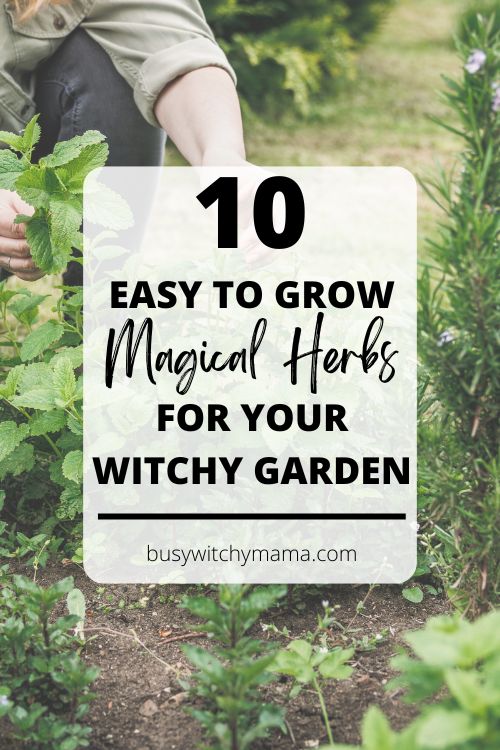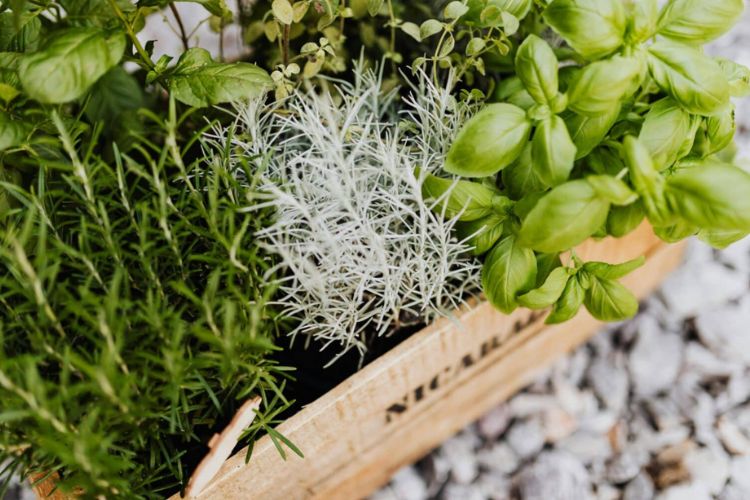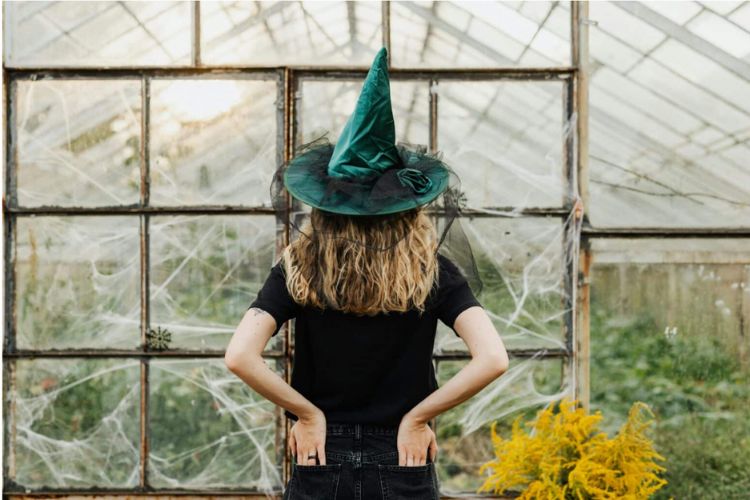
As we approach Imbolc and begin our transition back toward spring, it’s the perfect time to start planning out your witchy garden for the coming growing season. With magical herb and medicine cabinets dwindling, witches start sourcing refills for the spring and summer, a time when many of us are more magically active.
You can absolutely purchase your dried herbs online, but if you want to add an energetic boost to your magical herbs, practice sustainable magic, and maybe even save a buck, consider growing and harvesting your own magical herbs! Even witches with no growing experience can succeed with these easy-to-grow herbs and plants with powerful magical and medicinal uses. This post will focus on some of the best and easiest magical herbs to grow in your own witchy herb garden.
Busy Witchy Mama is a participant in the Amazon Services LLC Associates Program, an affiliate advertising program designed to provide a means for sites to earn advertising fees by advertising and linking to Amazon.com. This post may contain affiliate links through Amazon or other affiliate programs. If you choose to make a purchase through an affiliate link, I make a small commission at no additional cost to you. All opinions are my own and I only recommend products that I believe in. Read my full disclosure here. Thank you for your support!
Table of Contents
ToggleWhy Plan a Witchy Garden in Winter?
The month of February brings the energy of potential and hope for the future as the first bulbs of spring begin to shoot early blooms up through the snow and frozen ground. It’s the promise that while winter isn’t yet finished, there will be warmth and sun and abundance once more! Energetically, plants, animals, and even witches are starting to stir from periods of dormancy. The world around us is starting to wake up and prepare for the active time of year again.
As a result, this point in the year is also ideal for starting to come out of your own personal hibernation period. Start thinking about your goals for the year. We’ve been resting and building up our energy as we prepare to take action on new goals for the year.
Gardening is inherently witchy. It’s in our nature to want to connect to the spirits of the land and plants around us. Transforming a dried little seed into a thriving, living creation is, on its own, an act of magic. Using your creations in spell work is a nice bonus, though. Gardening is also a wonderful act of rebellion against organized systems if that’s where your heart lies. Of course you’re drawn to growing your own witchy garden!
If you’re a bit of a green thumb, you might also know that winter is the best time to start planning your spring garden and collecting supplies. Ideally, this would be done earlier in the winter. If, instead, you claimed the first half of winter as a season of rest, it’s not too late to start planning now! Very cold and very warm climates must often start seeds indoors in order to either avoid freezing seedlings through the remaining winter or roasting mature plants as summer approaches.
Depending on your growing zone and what you want to grow, it might already be time to start sprouting and tending to seedlings for planting in a month or two. Even if you plan to put seeds straight into the ground, you’ll want to start sourcing them now. Also, some witchy herbs can’t be purchased at your local plant nursery or hardware store.
Want more garden magic? Check out these posts!

Easy Growing Herbs for Your Witchy Garden
If you’re new to gardening, or notorious for killing plants (guilty as charged here), you’re in luck! There are many herbs and plants that will grow easily in a witchy garden. Even if you don’t have an abundant plant, these options will often produce something you can harvest and use in your magical practice!
1. Mint
It feels like cheating to start off with mint, but it’s an absolute powerhouse both magically and in the kitchen. It’s easy to grow, hard to kill, and spreads like wildfire – the perfect beginner witchy. garden herb.
Magical uses – Mint’s robust nature makes it ideal for spells centered on abundance, growth, spreading, and financial growth. It’s also great for spells involving mental clarity, focus, and memory. Use mint in your incense and herb blends, magical oils, magical powders, spell jars, candle dressings, and more.
Home uses – Mint has so many uses in the kitchen! You can use it to make your own extracts, infusions, sauces, and baked goods. Use it in homemade mouthwash or toothpaste. Make a soothing heating pad by adding rice and mint to a sock or fabric pouch, and microwave to heat. It also make a refreshing cup of tea! Mint can even soothe headaches and upset stomach.
Growing Tips – Mint prefers moist soil and not too much sun. Provide shade in hot climates or lots of sun in cooler, wet climates. It will grow from cuttings, so you can even pull clippings from another plant to start yours.
Special considerations – Mint will take over wherever you plant it. As a result, it’s not recommended to directly sow mint seeds in the ground unless you want a mint yard/neighborhood. Stick to a pot for this one. That way, you can control the spread a little better. It’s also toxic to cats.
2. Basil
Basil is a popular magical herb in many witchy cabinets, and it’s very beginner friendly in a witchy garden, too. I’ve grown robust, 4 foot tall basil plants in the square of a cinderblock!
Magical uses – The large, green, paper-like leaves of basil make it well suited to any working involving money and finances. Many witches use basil in spells for love, peace, success, and abundance. Some practices use it in protection magic or cleansing rituals by sprading it across thresholds or dipping stalks in water and sprinkling it throughout the home. It can even be used as a non toxic alternative in home made flying ointments.
Home uses – Basil makes a great addition to witchy salads, soups, and stews. Blend up a magical pesto or infuse your own basil oil for cooking and annointing. It has antioxidant, anti-bacterial, and anti-inflammatory properties that make it good for the blood, joints, teeth, and skin.
Growing Tips – Basil prefers warm weather and rich, moist soil for ideal growth. It can’t survive freezing temperatures and is damaged by temperatures below 40 degrees F/4 degrees C. For sturdy, bushy plants that produce lots of leaves, learn how to prune basil. These plants act a lot like the hydra of Greek Mythology. Cut back one stem, and two grow in its place! Search for a video tutorial that will explain exactly where and how to prune basil plants and pinch of bolting flowers for ideal harvests.
Special considerations – Consuming large amounts of basil may impact sperm motility and interact negatively with blood thinners.
3. Thyme
My personal favorite witchy garden herb to grow, it comes in a variety of types! Thyme is the perfect magical and pantry staple for any witch. Grab a traditional English thyme or mix it up with a fresh and citrusy lemon thyme.
Magical uses – Thyme is often used in workings related to courage, protection, and psychic ability. You can also use it in workings related to love and romance. If you work with fairy energy, thyme should be part of your practice! It can be used in magical herb blends, powders, oils, candle dressings, teas, and smoke cleansing bundles.
Home uses – Thyme is delicious in many foods and pairs well with other Italian seasonings. It’s good in soups, stews, poultry, veggies, salads, eggs, seafood, and herbed butters. Thyme is antimicrobial, antioxidant, and anti-spasmodic, making it useful for overall well being. It may also benefit stress reduction, oral health, digestive health, respiratory health, and menstrual discomfort.
Growing Tips – Thyme likes well draining soil with lots of sun and can tolerate drought better than many plants. It can be grown from clippings instead of seeds if desired. Thyme, like mint, tends to spread. Though it’s not as invasive as mint, a potted plant is prudent. Trim regularly at the fresh, green stems often to encourage health and hardy growth of the plant.
Special considerations – Heavy consumption of thyme can cause upset stomach and interfere with blood clotting.
4. Rosemary
No witchy herb list is complete without rosemary. It’s incredibly useful and such a hardy plant that has been used in magical workings for centuries.
Magical uses – Rosemary brings powerful healing energy to spells related to health and healing. Its prickly needles and woody stems also make rosemary ideal for protection magic. If you do any ancestor work, consider adding rosemary to your cabinet. It’s a common ingredient in herb bundles for smoke cleansing. I love using the dried, woody stems to make altar decor during Samhain and Yule!
Home uses – Rosemary lends a wonderful flavor to savory dishes and is often paired with meats and nuts. Tea made with rosemary can support gut health, and adding rosemary oil to your hair products can help hair growth and strength. Talk about a simple piece of glamour magic! Rosemary may also improve your mood, and the smell of fresh rosemary stalks was the only thing that eased morning sickness with my second witchling.
Growing Tips – Rosemary likes well draining soil and hot, sunny days. Plant it in a place that’s protected from too much wind, and prune often for strong, bushy plants. Rosemary will need protection in winter, but its hardy nature means it can last for years.
Special considerations – Take caution with high amounts of rosemary consumption if you are on ace inhibitors, diuretics, or lithium for health conditions.
5. Stinging Nettle
s Considered a weed by most, you might be able to find this magical plant growing naturally at your local park.
Magical uses – The name alone suggests stinging nettle’s benefit in protection, warding, and banishing, but that’s not all! It can also be used in spells for healing, love, fertility, vitality, purification, and as a part of your divination practice. As a weed, it also carries the energy of growth and progress, especially personal growth goals. Dried stalks can be used to make fiber-like threads and paper for use in crafts and spell work. Imagine working your own weaving spell with home grown and hand made nettle yarn!
Home uses – Stinging nettle is packed with essential nutrients that support the body. Nettle greens are often added to soups and stews for a nutritional punch. It should never be eaten raw and is always be cooked first. Centuries ago, arthritis pain was treated by flogging the area with nettle leaves because the painful sting improves circulation. Nettle tea may even support milk production in nursing and lactating people.
Growing Tips – Nettle isn’t picky about its growing conditions. For the best flavor, though, keep the soil evenly moist and nitrogen rich.
Special considerations – Stinging nettle is covered with tiny needles that, well, sting when touched. The sensation is quite painful. When harvesting, wear thick gloves, long sleeves, and jeans to avoid stinging. In food, you can neutralize the needles by steaming the leaves before use. It spreads like wildfire in the garden. Consequently, consider growing in a pot or dedicated space in the garden. You should also harvest the plants before they flower. This will prevent them from taking over.
6. Purslane
Even if you’ve never heard of purslane, I bet you’ve seen it! That’s because it grows invasively in pretty much all environments. You’ll find it sprouting in open fields just as easily as cracks in concrete.
Magical uses – Purslane’s invasive nature and tangled, messy growth pattern means that it’s well aligned to protective magic. A sprig under your bed is said to prevent nightmares. If you are casting a working for something to take root, purslane is your BFF. Every part of this plant can root and take over. Because it is also hardy and fast growing, purslane can be used in abundance and prosperity workings. If adding purslane to spell powders, dry it very well to avoid spoilage. Due to its mucousy nature, purslane avoid using in spell oils.
Home uses – Purslane is a nutritional powerhouse that’s packed with vitamins and minerals. In fact, purslane has more Omega-3 fatty acids than salmon! It has a lemony, nutty flavor and can be eaten cooked or raw in soups, stews, and salads. Purslane also makes an excellent thickener that works similarly to the mucilage in okra pods.
Growing Tips – Purslane is hardy and invasive. While it dies off with the cold, this creeping succulent is unfazed by hot, dry summer sun and poor soil.
Special considerations – If cultivating instead of foraging, grow it in a pot. Once it spreads in the soil, there’s basically no getting rid of it. A single piece of purslane in the soil can take root and spread.
7. Cucumber Blossoms
Cucumber blossoms are the powerful garden item that you’re probably not using yet, but you should be! A single cucumber plant can provide hundreds of blossoms and still give cucumbers, too.
Magical uses – Cucumbers carry the energy of abundance and fertility, so this energy is also carried into the blossoms. Flowers precede fruit, so cucumber blossoms can help with the steps that lead up to big goals. All fruit and veggie flowers are also naturally aligned with fertility and creation. Use cucumber blossoms to manifest big goals, especially related to fertility, abundance, romance, beauty, and creativity. For a bit of garden magic, charge your plant with an intention. Then hand pollinate your flowers to fill them with your personal energy. As your cucumbers grow, so does your intention! Use them in magical herb blends, powders, oils, and candle dressings. If you work with Aphrodite, cucumber blossoms can be used as offerings or in workings related to her.
Home uses – Cucumber blossoms are actually edible. They have a fresh, cucumber like flavor that works well as a topping in spring salads. Their vibrant yellow color attracts happiness, confidence, and joy to your kitchen magic.
Growing Tips – Cucumber plants prefer moderate temperatures, partial sun, and moist, rich, well draining soil. If your plant isn’t flowering, this usually means you need add fertilizer to the soil.
Special considerations – Waste not, want not. Most of the early flowers that bloom on a cucumber plant are male and won’t turn into a cucumber. They will fall off the plant to make way for a second bloom that includes female flowers. Gather up the early flowers that fall, and pinch off excess male flowers throughout the growing season to prevent bitter cucumbers.
8. Mugwort
Mugwort is a the ultimate witchy herb that you always hear about in magical circles. While mugwort can be difficult to find in most stores, it’s actually pretty easy to grow. Once established, you’ll have all the mugwort you could ever need.
Magical uses – Mugwort is often associated with dreams and spirit work because it is slightly psychoactive and can support visions, divination, and prophetic dreaming. This potent plant also supports building self confidence and trust in your body. It may also be protective, supporting one through major transitions. Use with caution in herb blends and incense blends, ritual oils, teas, baths, and candle dressings. Add it to dream pillows to bring vivid dreams and practice dream work.
Home uses – Mugwort tea may support a healthy digestive and reproductive system. It’s also a strong nerve tonic that can help ease stress and anxiety. Fresh mugwort leaves can be added to soups and stews, and the dried herb can also be smoked if that’s your jam.
Growing Tips – Mugwort tolerates poor soil and drought conditions once established, but for best results, it likes well draining soil and sun. Seeds require a cold period to germinate. You can cold stratify the seeds naturally by sowing them in fall or winter. This can also be done by placing seeds in the fridge with a damp paper towel for 2-4 weeks before sowing. Check state regulations before planting. Some states have legislation that makes planting mugwort illegal due to its invasive nature.
Special considerations – Mugwort can cause allergic reactions in someone already allergic to birch, kiwi, peach, mango, apple, celery, carrots, cabbage, grass, hazelnut, olive pollen, honey, mustard, royal jelly, sweet bell pepper pollen, tobacco, and sunflower. When steeping tea, you should begin with 1-1.5 tsp of dried mugwort and steep for 10 minutes. Watch carefully for negative reactions or emotions. Mugwort is technically toxic, but you’d have to use very large doses to reach toxicity.
9. Chamomile
Chamomile is well known as a calming herbal tea, but it’s magical uses go far beyond that. Delicate flowers add to a beautiful witchy garden.
Magical uses – Chamomile is an herb of luck, happiness, protection, purification, and transformation. Since it aids with sleep, it’s a beneficial addition to soothing baths before bed, dream pillows, and dream tea blends. Planting it around your home works as natural protection from evil and harm. Chamomile is gentle and safe for most people. As a result, it works in herb blends, powders, ritual oils, teas, herbal baths, spell jars, pouches, poppet magic, and whatever else you can dream up!
Home uses – Chamomile tea soothes the stomach and eases stress and anxiety. As a mild tranquilizer, it supports healthy sleep habits. Added to a bath or applied to the skin, it helps sooth skin irritation and conditions. You can even eat the blossoms in salads and use dried herbs to infuse jams and jellies with its mild tea flavor.
Growing Tips – Chamomile seeds prefer cool, moist soil to germinate. It likes well draining soil, and does well in pots or directly in the ground.
Special considerations – Chamomile tea is made from the flowers of the plant. You can make herbal tea with fresh or dried flowers, and you’ll get a slightly different flavor profile for each one. Avoid use if you are allergic to ragweed, daisies, chrysanthemums, or asters.
10. Tomato Leaves
If you’re growing tomatoes this spring, consider also harvesting tomato leaves for magical workings. The plants have to be pruned anyway. You might as well put the cuttings to good use.
Magical uses – Tomatoes are part of the nightshade family, which includes many baneful and toxic herbs like belladonna, banewort, devil’s herb, and mandrake. While tomato leaves are harmless, as a nightshade, they serve as a non toxic alternative to baneful herbs in curses, hexes, and bindings. Without proper care, vines grow brambly and out of control, and the leaves have a very signature pungent scent, lending the energy of protection and banishing to the plant.
Home uses – Tomato leaves can actually be eaten. They add a grassy, herbacious flavor to tomato sauces, soups, and stews. Tomato leaves also make a flavorful dish similar to pesto. They have a strong odor that deters pests, so you could use a sachet of tomato leaves to keep bugs away.
Growing Tips – Tomatoes take some work to grow, but the leaves pretty much take care of themselves. Healthy plants need regular pruning. Keep healthy, disease free trimmings for personal use. Tomato plants like nutrient rich, well draining soil that’s not too dry and hot, sunny weather. They dislike the cold and can’t tolerate a freeze.
Special considerations – Eating too many leaves can be poisonous, and the leaves are much more palatable once cooked. Raw leaves have a prickly, fuzzy texture that’s not very pleasant in the mouth.

What's Growing in Your Witchy Garden?
Now that you have some ideas for witchy garden herbs that are easy to grow, it’s time to start planning out your garden and gathering your supplies!
Growing your own magical herbs is rewarding. It allows you to get back into nature, work with the energy of the Earth, and infuse your own personal power into the herbs in your magical herb cabinet.
Time to get your hands dirty and make some magic.

